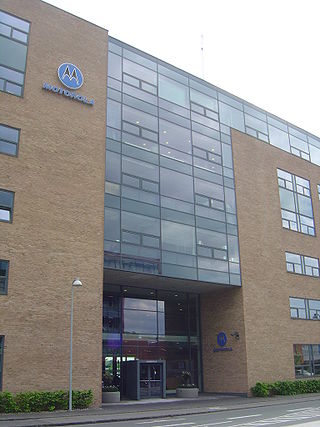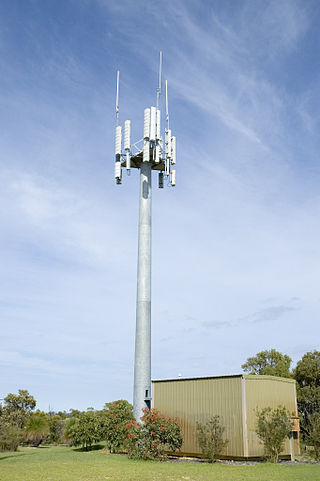
Advanced Mobile Phone System (AMPS) was an analog mobile phone system standard originally developed by Bell Labs and later modified in a cooperative effort between Bell Labs and Motorola. It was officially introduced in the Americas on October 13, 1983, and was deployed in many other countries too, including Israel in 1986, Australia in 1987, Singapore in 1988, and Pakistan in 1990. It was the primary analog mobile phone system in North America through the 1980s and into the 2000s. As of February 18, 2008, carriers in the United States were no longer required to support AMPS and companies such as AT&T and Verizon Communications have discontinued this service permanently. AMPS was discontinued in Australia in September 2000, in Pakistan by October 2004, in Israel by January 2010, and Brazil by 2010.

Motorola, Inc. was an American multinational telecommunications company based in Schaumburg, Illinois. It was founded in 1928 as Galvin Manufacturing Corporation by brothers Paul and Joseph Galvin. The company changed its name to Motorola in 1947. After having lost $4.3 billion from 2007 to 2009, the company split into two independent public companies, Motorola Mobility and Motorola Solutions, on January 4, 2011. The reorganization was structured with Motorola Solutions legally succeeding Motorola, Inc., and Motorola Mobility being spun off.

Kyocera Corporation is a Japanese multinational ceramics and electronics manufacturer headquartered in Kyoto, Japan. It was founded as Kyoto Ceramic Company, Limited in 1959 by Kazuo Inamori and renamed in 1982. It manufactures industrial ceramics, solar power generating systems, telecommunications equipment, office document imaging equipment, electronic components, semiconductor packages, cutting tools, and components for medical and dental implant systems.
Rogers Wireless Inc. is a Canadian wireless telephone company headquartered in Toronto, providing service nationally throughout Canada. It is a wholly owned subsidiary of Rogers Communications. The company had revenues of just under $15.1 billion in 2018. Rogers Wireless is the largest wireless carrier in Canada, with 10.8 million subscribers as of Q3 2020.

Mobile telephony is the provision of telephone services to mobile phones rather than fixed-location phones. Telephony is supposed to specifically point to a voice-only service or connection, though sometimes the line may blur.

The history of mobile phones covers mobile communication devices that connect wirelessly to the public switched telephone network.

KT Corporation, formerly Korea Telecom, is a South Korean telecommunications company. KT is the second-largest wireless carrier in South Korea, with 16.493 million subscribers as of Q4 2017.

Martin Cooper is an American engineer. He is a pioneer in the wireless communications industry, especially in radio spectrum management, with eleven patents in the field.
Mobile television is television watched on a small handheld or mobile device, typically developed for that purpose. It includes service delivered via mobile phone networks, received free-to-air via terrestrial television stations, or via satellite broadcast. Regular broadcast standards or special mobile TV transmission formats can be used. Additional features include downloading TV programs and podcasts from the Internet and storing programming for later viewing.

BenQ Corporation is a Taiwanese multinational company that sells and markets technology products, consumer electronics, computing and communications devices under the "BenQ" brand name, which stands for the company slogan Bringing Enjoyment NQuality to life. Its principal products include TFT LCD monitors, projectors, interactive displays, speakers, lighting, peripherals, and mobile computing devices.
Skyhook is a location technology company based in Boston, Massachusetts, that specializes in location positioning, context, and intelligence. Founded in 2003, Skyhook originally began by geolocating Wi-Fi access points. It has since then has been focusing on hybrid positioning technology, which incorporates with Wi-Fi, GPS, cell towers, IP address, and device sensors to improve device location.

A mobile phone is a portable telephone that can make and receive calls over a radio frequency link while the user is moving within a telephone service area, as opposed to a fixed-location phone. The radio frequency link establishes a connection to the switching systems of a mobile phone operator, which provides access to the public switched telephone network (PSTN). Modern mobile telephone services use a cellular network architecture and therefore mobile telephones are called cellphones in North America. In addition to telephony, digital mobile phones support a variety of other services, such as text messaging, multimedia messagIng, email, Internet access, short-range wireless communications, satellite access, business applications, video games and digital photography. Mobile phones offering only basic capabilities are known as feature phones; mobile phones which offer greatly advanced computing capabilities are referred to as smartphones.

In telecommunications, long-term evolution (LTE) is a standard for wireless broadband communication for mobile devices and data terminals, based on the GSM/EDGE and UMTS/HSPA standards. It improves on those standards' capacity and speed by using a different radio interface and core network improvements. LTE is the upgrade path for carriers with both GSM/UMTS networks and CDMA2000 networks. Because LTE frequencies and bands differ from country to country, only multi-band phones can use LTE in all countries where it is supported.

The BOLT Browser was a web browsing system for mobile phones including feature phones and smartphones able to run Java ME applications. The BOLT browser was installed on the phone, and BOLT servers accessed Web pages, processed and compressed them, and delivered them to phones running the browser. The BOLT Browser was offered free of charge to consumers, and by license to mobile network operators and handset manufacturers. BOLT was produced by Bitstream Inc., the company which previously produced ThunderHawk for mobile network operators and handset manufacturers. BOLT was originally introduced into private beta on January 15, 2009 and was made available to the public on February 16, 2009 when the public beta was announced at Mobile World Congress in Barcelona. BOLT supported Java-based handsets with Java MIDP 2 and CLDC 1.0 or higher. BOLT also has specially optimized version for BlackBerry smartphones and worked with Windows Mobile and Palm OS devices that employ a MIDlet manager or Java emulator. BOLT was built using the WebKit rendering engine to display a full Web page layout as found on desktop web browsers.
WorldCell is an American-based corporation that provides international mobile service to federal agencies, international businesses, and individual travelers.

ip.access Limited is a multinational corporation that designs, manufactures, and markets small cells technologies and infrastructure equipment for GSM, GPRS, EDGE, 3G, 4G and 5G. The company was acquired by Mavenir in September 2020.
Republic Wireless was an American mobile virtual network operator (MVNO). Republic sold low cost mobile phone service on partner networks. Republic started as a unique company that provided customers with VOIP numbers which relied on WiFi first with cell as a backup.
In most jurisdictions, prison inmates are forbidden from possessing mobile phones due to their ability to communicate with the outside world and other security issues. Mobile phones are one of the most smuggled items into prisons. They provide inmates the ability to make and receive unauthorized phone calls, send email and text messages, use social media, and follow news pertaining to their case, among other forbidden uses.
A projector phone is a mobile phone that contains a built-in pico projector.











